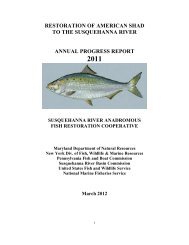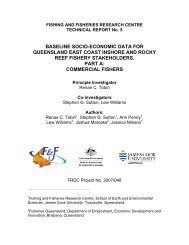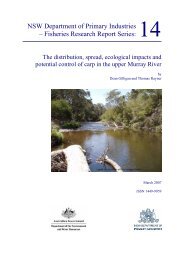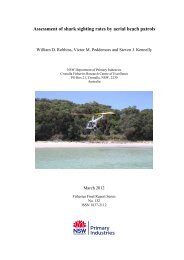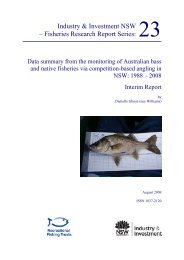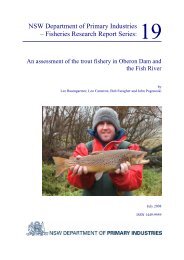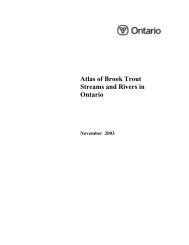The freshwater macrophytes of - Fisheries Reports
The freshwater macrophytes of - Fisheries Reports
The freshwater macrophytes of - Fisheries Reports
Create successful ePaper yourself
Turn your PDF publications into a flip-book with our unique Google optimized e-Paper software.
NSW Dept <strong>of</strong> Primary Industries 27<br />
5. CONCLUSIONS<br />
1. <strong>The</strong> LPI streamflow network for the subcatchments <strong>of</strong> the Parramatta River was inadequate for<br />
the purpose <strong>of</strong> this survey. To cater for this deficiency we created a more robust base map <strong>of</strong><br />
tributaries.<br />
2. A useful baseline <strong>of</strong> the submerged, emergent and floating <strong>freshwater</strong> <strong>macrophytes</strong> <strong>of</strong> the<br />
Parramatta River has been created.<br />
3. <strong>The</strong> distributional data acquired can be used to assess change over time.<br />
4. Neither the native Vallisneria gigantea nor the alien Juncus acutus were found. <strong>The</strong> latter was<br />
not necessarily expected as its distribution is reported to only be in tidal water.<br />
5. Two aquatic Weeds <strong>of</strong> National Significance, Alternanthera philoxeroides and Salvinia<br />
molesta, and one weed on the National Alert List, Gymnocoronis spilanthoides, show limited<br />
distribution and should be <strong>of</strong> high priority for eradication.<br />
6. Because other aquatic weeds appear to be limited in their distribution, eradication projects<br />
appear to be viable.<br />
7. Distinct differences in the geology <strong>of</strong> the subcatchments do not appear to markedly influence<br />
the species composition <strong>of</strong> <strong>freshwater</strong> aquatic vegetation in each.<br />
8. <strong>The</strong> data obtained in this project would be useful in modelling the distribution <strong>of</strong> aquatic<br />
vegetation in the sandstone formed estuaries <strong>of</strong> NSW.<br />
6. RECOMMENDATIONS<br />
1. <strong>The</strong> methodology in this report should be combined with the WHS methodology (Earth Tech<br />
2007) such that future surveys would simultaneously note riverine (on-bank) and in-stream<br />
(submerged, emergent and floating) native vegetation.<br />
2. <strong>The</strong> data in this report should be combined with the WHS data (Earth Tech 2007) to elicit<br />
relationships between riverine and in-stream native vegetation.<br />
3. <strong>The</strong> combined data set should be used to refine the distributions <strong>of</strong> alien species and implement<br />
appropriate management plans. Some sites may need to be mapped in more detail.<br />
4. A pest species eradication project should be initiated, particularly at those sites where more<br />
than one exotic species was located (Upper Parramatta River: Archer Creek; Lane Cove River:<br />
Ulm, Links and Doncaster Creeks; Middle Harbour Creek: Carroll Creek).<br />
5. A follow-up survey should be conducted in two years to assess whether pest and/or native plant<br />
species have increased in range.<br />
6. Contingent on #4 (above), an analysis <strong>of</strong> change <strong>of</strong> landuse in the subcatchments should be<br />
undertaken to assist in identifying sites for which there is an enhanced susceptibility <strong>of</strong> weed<br />
invasion.<br />
7. An assessment <strong>of</strong> landuse should include an integration <strong>of</strong> aquatic plant distribution data with<br />
the locations and characteristics <strong>of</strong> stormwater outlets and sewage overflows. Other data as<br />
acquired from future monitoring should also be applied. <strong>The</strong> output will further focus<br />
management plans and additional investigations.<br />
8. Multivariate analysis <strong>of</strong> the data acquired in this report should be undertaken to stratify habitat<br />
subunits.<br />
9. Habitat subunits should be sampled to identify in situ fish assemblages after the method <strong>of</strong><br />
Gilligan and Heath (in prep.).<br />
10. Surveys <strong>of</strong> the <strong>freshwater</strong> aquatic vegetation <strong>of</strong> other rivers in the SMCMA should be initiated,<br />
with close attention paid to the accuracy <strong>of</strong> available maps and the need to make corrections to<br />
the tributary network.<br />
Freshwater <strong>macrophytes</strong> <strong>of</strong> the Parramatta Catchment (Williams and Thiebaud)




